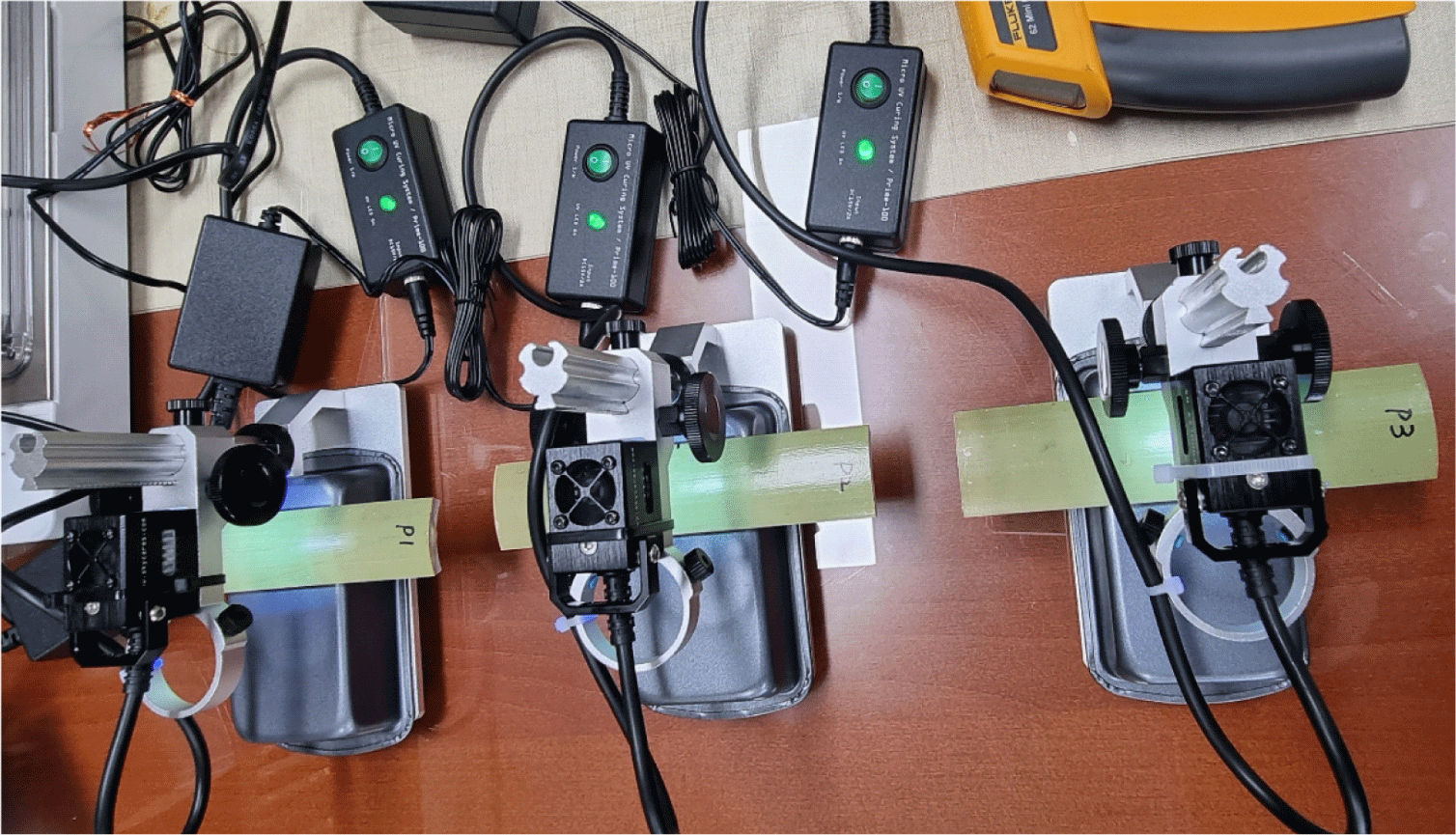1. INTRODUCTION
Bamboo is a fascinating material owing to its high growth rate, high strength, easy workability, and vivid color. Color is an attribute of visual perception that can significantly affect the preference of customers toward bamboo and wood products (Lee and Lee, 2021). Bamboo materials can be used for various exterior applications, such as outdoor furniture, household goods, and handicrafts, which are susceptible to solar radiation. Recently, Galih et al. (2020) investigated the mechanical properties of hybrid cross-laminated timber with a bamboo laminated board as the core layer. However, solar radiation can discolor bamboo surfaces and initiate cracking. Therefore, anti-light aging techniques are sought after in the bamboo industry (Yu et al., 2018).
Ultraviolet (UV) light has a short wavelength, and its energy is sufficiently high to cleave many critical functional groups and linkages in bamboo components such as lignin, cellulose, and hemicellulose (Rao et al., 2019). Kim and Kim (2019) conducted an outdoor exposure test to evaluate wooden structure members accurately for one year. They discovered a significant relationship between the outdoor exposure time and color differences. Kim and Kim (2021) investigated the UV deterioration characteristics of seven wood species painted with natural oils, stains, and varnish paints. They discovered that the color change of the painted wood was less significant than that of unpainted wood.
Studies show that wood discoloration is primarily caused by the degradation and transformation of lignin and extractives. Kang et al. (2003) reported that the acetylation of Prunus sargentii reduced its hygroscopicity and discoloration after it was exposed outdoors for more than two months. Park et al. (2018) investigated the effects of several chemical treatments (alcohol-benzene, hydrogen peroxide, and hypochlorite solutions) to prevent the photodegradation of walnut wood veneer. Despite the removal of extractive compounds, which are known as discoloration components, they observed a significant color change in the walnut wood veneer. The chromophores in lignin are the primary cause of wood discoloration. Park et al. (2022) delignified wood (Larix kaempferi and Quercus mongolica) surfaces to stabilize them against weathering due to UV light. The wood surface color did not change significantly after UV light exposure following surface delignification through peracetic treatment.
Bamboo is abundant in phenolic acids and has a relatively high lignin content (Peng et al., 2012). Yu et al. (2018) reported that a series of photochemical reactions occurred on the top surface of Moso bamboo after UV irradiation. During this process, the lignin content decreased owing to degradation, and the amount of extractives increased. They concluded that the surface color changes of the bamboo were closely related to its chemical composition. Lignin is considered as the most easily photodegradable component of wood and bamboo. Because of the numerous active groups in lignin and the low binding energy of most carbon-oxygen bonds, the secondary alcohols, hydroxyl, carboxyl, aromatic, and phenolic groups on lignin tend to form free radicals under UV exposure. The constant generation of free radicals results in the photodegradation of lignin and is considered the main reason contributing to the photodegradation of bamboo (Rao et al., 2022). However, studies regarding the photodiscoloration of heat-treated bamboo are rare.
The culm of bamboo is shielded by a hard epidermis with a wax-coated skin, which prevents moisture loss from bamboo (Arffin and Sukri, 2019). Li et al. (2007) reported the highest extractive and ash contents and the lowest holocellulose and cellulose contents in the epidermis of Phyllostachys pubescens bamboo culms. Chang et al. (2015) discovered that giant bamboo (Dendrocalamus giganteus Munro) culm wax is composed of saturated and unsaturated hydrocarbons, including alkanes, alcohols, ketones, aldehydes, fatty acids, and minor aromatic compounds. However, studies regarding the photodiscoloration of the bamboo epidermis are scarce.
The objective of the present study is to investigate the photodiscoloration of Phyllostachys bambusoides bamboo, which is one of the main bamboo species in Korea. Artificial UVA light sources are used to simulate solar UVA and accelerate the aging of the bamboo’s outer surface.
2. MATERIALS and METHODS
The culm of P. bambusoides bamboo used in this study was obtained near Damyang-gun, Jeollanam-do, Republic of Korea. In 2021, more than 18,000 tons of bamboo were produced in Korea (Korea Forest Service, 2022). The bamboo species were verified based on information by the manufacturer. The bamboo culms were cut into 150-mm-long cylindrical specimens with no nodes at either end.
Twelve bamboo culm specimens were selected and air-dried for approximately one month (June 30, 2021 to July 28, 2021). The average circumference, thickness, and moisture content of the green specimens were 76.95 mm, 5.63 mm and 50.7%d.b., respectively. Air-dried specimens with average moisture content of 13.6%d.b. were hot-air dried at 60°C for 8 hours. The average moisture content of the hot-air-dried specimens was 7.4%. Six among twelve of the hot-air-dried specimens were oven dried and heat treated with hot air at 200°C for 2 hours [severity factor (SF) 5.02]. Lee and Lee (2021) recommended an appropriate SF range of 4.72–5.61. The SF used in this study is expressed as follows:
where t is the heat treatment time in minutes, TH the heat treatment temperature in °C, and TR the reference temperature (= 100°C).
Each of the 12 bamboo culm specimens was segregated into 30-mm-wide and 150-mm-long samples. Six samples without any contamination were selected as hot-air-dried and heat-treated samples. Three samples were selected from the hot-air-dried and heat-treated samples, and their outer surfaces were coated with transparent UV-protective paint to investigate the effect on discoloration prevention. A commercial acrylate emulsion-type UV-protective paint, BONDEX Bamboo Care (DYRUP A/S, SBONDE, Denmark), was used. An acrylic-based coating containing UV absorbers is expected to effectively improve the photostability of the bamboo surface and delay the photodegradation of the coating (Zhang et al., 2022). The samples were coated thrice at 1 hour intervals, as recommended by the manufacturer.
UV light constitutes only ~6.8% of solar radiation. However, owing to its high energy, it can destroy many chemical bonds in the main components of bamboo (Rao et al., 2022). Solar UV radiation is characterized based on its wavelength as UVA (315–400 nm), UVB (280–315 nm), or UVC (100–280 nm). UVC from the sun is virtually completely eliminated by the Earth’s atmosphere. Most of UVB light from the sun is absorbed by the Earth’s atmosphere (Gallagher et al., 2010). Therefore, the primary solar UV radiation on the Earth’s ground surface can be characterized as UVA. Based on 16 years’ (1988–1989 and 1996–2010) worth of data, Jo et al. (2012) reported that the average solar UVA and UVB radiation on horizontal surfaces in Korea was 0.230 and 0.006 kWh/m2/day, respectively.
Previously, accelerated weathering tests of wood and bamboo were conducted in a weathering chamber equipped with a UV radiator. Topaloglu (2019) subjected test specimens to 8 hours of UV light irradiation, followed by 4 hours of condensation in a weathering test device. The mean irradiance was 0.89 W/m2 at a wavelength of 340 nm and the total exposure time to UV light was 4 weeks (672 hours), based on Cycle 1 in the ASTM G154 standard (ASTM, 2016). Yu et al. (2018) exposed Moso bamboo specimens to 0.68 W/m2 of UV light (wavelength = 310 nm) for 56 days (1,344 hours); typically, conventional weathering tests are time consuming.
However, in this study, artificial UV radiators were used to radiate intense UVA light onto bamboo samples to investigate surface discoloration within a short period. A micro UV light emitting diode (LED) curing system (Model PRIME-100 Series, Skycares, Gimpo, Korea) with six LEDs of 3 W each (total UVA output power = 18 W) was used to radiate UVA light (wavelength = 365 nm). An air cooling system was constructed, and the timer switched off the UV radiator for 10 min after every 30 min of radiation to prevent the UV radiator from being overheated.
Three UV radiators were attached to the stands to control the distance between the UV radiators and the sample surfaces (Fig. 1). The UV irradiance was measured based on the distance between the UV radiator and the target surface using a UV radiation meter (detectable wavelength range: 260–400 nm; Model LS125, Shenzhen Linshang Technology, Shenzhen, China). The UVA irradiance decreased as the distance between the UV radiator and the target surface increased. The distance between the UV radiator and the bamboo sample surface was set at 38 mm, where the UVA irradiance was expected to be 2,000 W/m2. The average annual total sunshine duration over nine years (from year 2013 to 2021) was 2,448.4 hours/year (6.71 hours/day) in Korea (KMA, 2022). Based on the average solar UVA radiation of 230 Wh/m2/day on horizontal surfaces in Korea (Jo et al., 2012), the average solar UVA irradiance can be estimated as 34.3 W/m2 (= 230 Wh/m2/day ÷ 6.71 hours/day). Therefore, the UVA irradiance of 2,000 W/m2 set in this study can be regarded as more than 58 times higher than the actual average solar UVA irradiance in Korea. For reference, Yu et al. (2015) estimated the average UVA irradiance level in southern China to be 25 W/m2.
The surface color changes of the samples owing to UVA radiation were measured periodically using a portable colorimeter (Model NR100, 3nh, Guangzho, China) fitted with an aperture with a diameter of 8 mm. This colorimeter features built-in white-plate parameters, which are used for calibration. The CIE L*, a*, and b* color parameters (based on the International Commission on Illumination) of the specimens were obtained directly from a colorimeter and used for color evaluation. A point was selected on the outer surface of each sample directly under the UVA radiator to measure the color changes at identical positions for 72 h. Color measurements were conducted only when the UVA radiator was switched off. Hadi et al. (2020, 2022) determined the level of discoloration in smoked and furfurylated wood samples by evaluating their color change (dE*). The overall dE* of the specimens was calculated as follows:
where dL*, da*, and db* represent the changes in the L*, a*, and b* of the samples, respectively. A lower dE* value indicates a less significant color change.
3. RESULTS and DISCUSSION
The outer surfaces of the bamboo samples after 72 h of artificial UVA irradiation are shown in Fig. 2. The area directly under the UVA radiator’s LEDs indicated discoloration on all the hot-air-dried and heat-treated samples, as observed with the naked eye. Changes in the color parameters of the outer surfaces of the bamboo after 72 hours of artificial UVA radiation are presented in Table 1. The average values of a* of the uncoated and coated samples increased from –1.20 to 10.43 and –1.95 to 7.36 after 72 hours of artificial UVA radiation, respectively. The average b* values of the uncoated and coated samples increased from 19.6 to 26.02 and from 19.74 to 25.39, respectively. However, the average L* was barely affected by UVA radiation (from 57.95 to 58.03 for the uncoated sample, and from 59.39 to 59.94 for the coated sample).
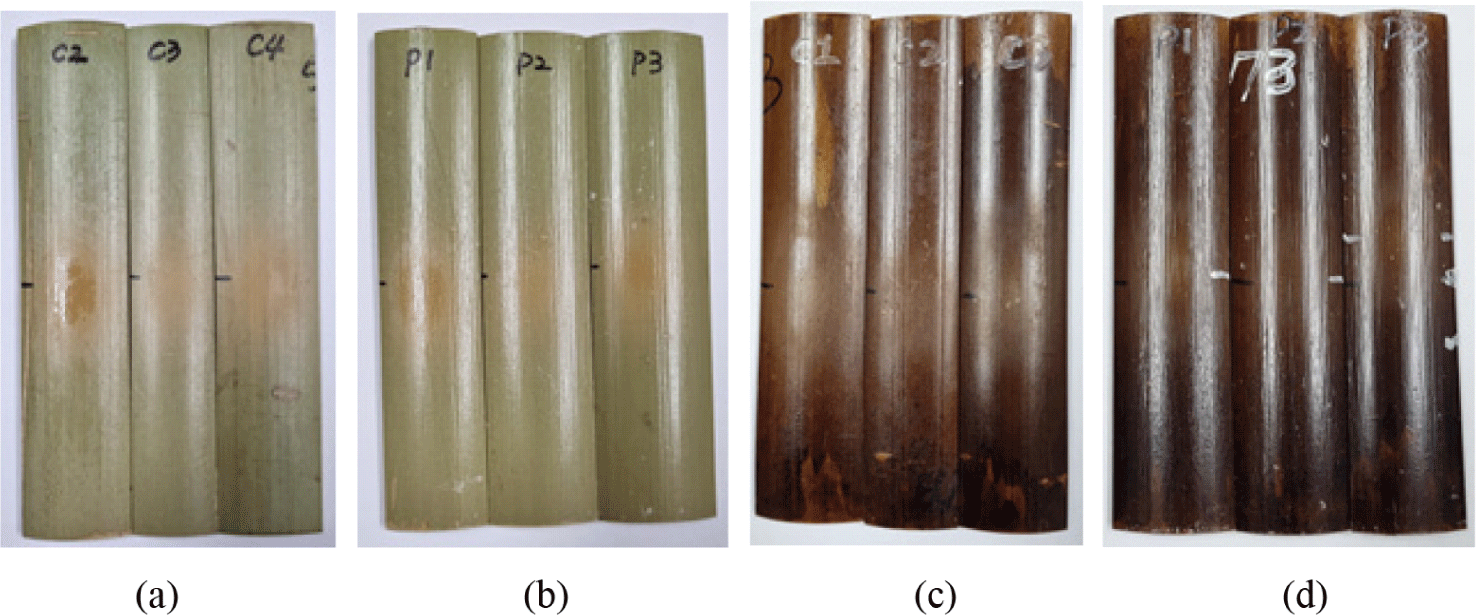
Figs. 3 and 4 show the changes in dL*, da*, and db* on the surfaces of the uncoated and coated samples, which were hot air-dried based on the UVA radiation time. Among the three color parameters, parameter a* showed the most significant change in both the uncoated and coated samples. Yu et al. (2021) reported that dE* increased rapidly at first and then stabilized when the bamboo surface was exposed to artificial UV light.
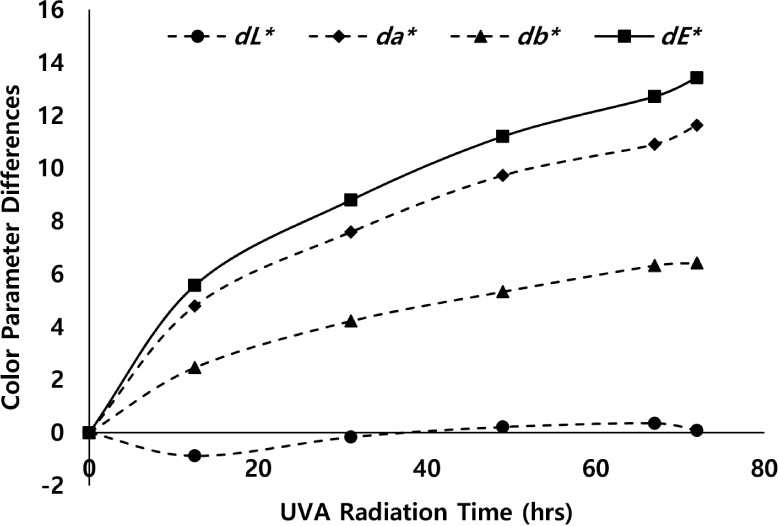
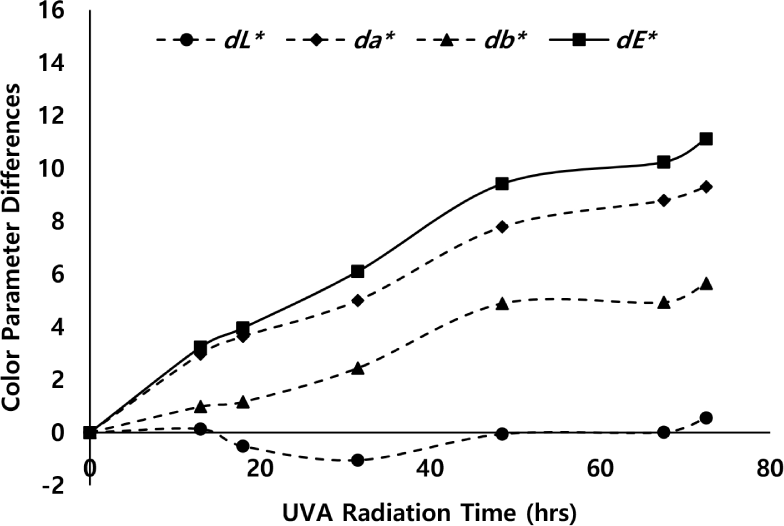
The overall dE* of the coated samples after 72 hours of UVA radiation was approximately 18% lower than that of the uncoated samples. This implies that the UV-protective coating cannot prevent the discoloration of bamboo’s outer surface when exposed to solar radiation for a long duration.
The radiation of UVA with an irradiance of 2,000 W/m2 for 42 hours is equivalent to the total UVA radiation of 84,000 Wh/m2 on the surface for the same radiation time. Based on the average solar UVA radiation of 230 Wh/m2/day on horizontal surfaces in Korea (Jo et al., 2012) this total artificial UVA radiation is equivalent to the total solar UVA radiation for approximately one year (84,000 Wh/m2 ÷ 230 Wh/m2/day = 365 days). Therefore, the radiation of UVA with an irradiance of 2,000 W/m2 for 72 hours is equivalent to the total solar UVA radiation for approximately 1.71 years.
Heat-treated bamboo cannot avoid discoloration caused by UV light. Figs. 5 and 6 show the changes in dL*, da*, and db* on the surfaces of the uncoated and coated heat-treated samples. The values of b* and L* increased with the UVA radiation time. The average b* values of the uncoated and coated samples increased from 0.10 to 12.73 and 2.01 to 9.60, respectively, after 72 hours of artificial UVA radiation. The average values of L* increased from 27.78 to 37.36 for the uncoated sample and from 27.17 to 35.3 for the coated sample. However, parameter a* did not change significantly, unlike the case of the hot-air dried samples, because it had already been altered significantly during the heat treatment. The average a* value of the uncoated and coated samples increased from 4.48 to 7.19 and 3.74 to 6.48, respectively.
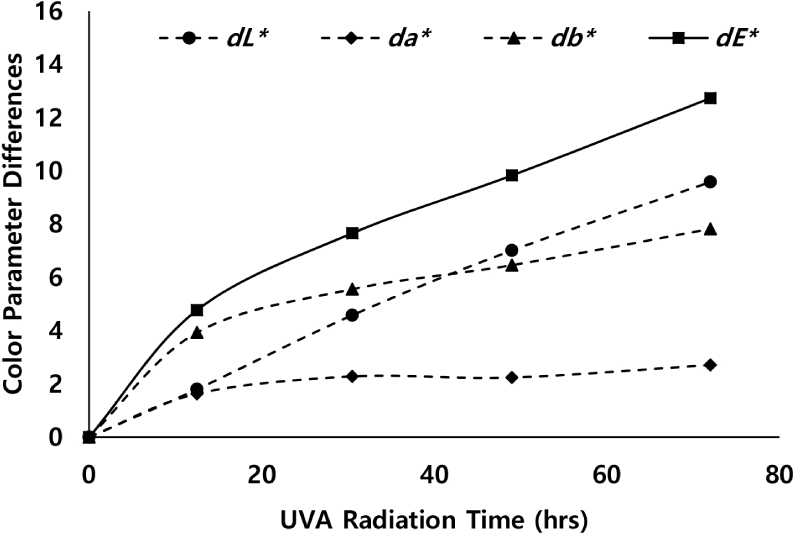
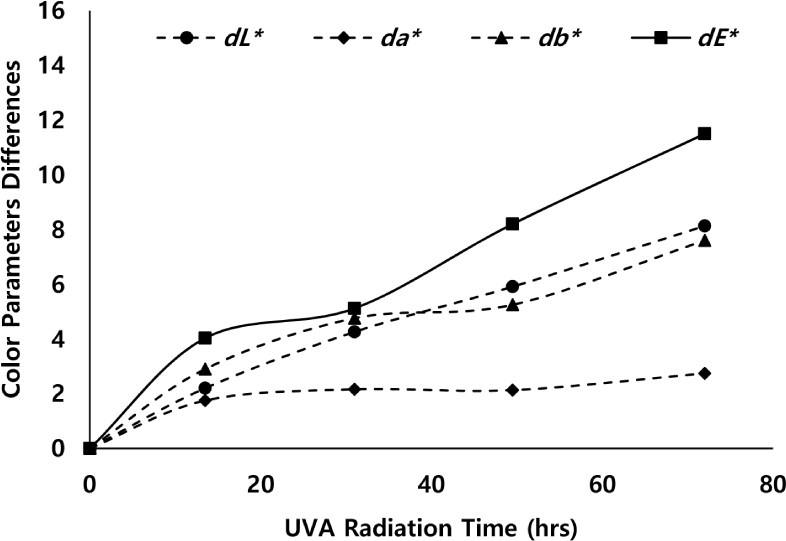
The overall dE* of the coated samples after 72 hours of UVA irradiation was approximately 10% lower than that of the uncoated samples.
Table 2 shows the regression analysis results for the relationship between the overall dE* of the bamboo’s outer surface and the UVA radiation time. Park et al. (2016) investigated the color change of wood via UV radiation based on sensitive expressions of color difference (3.0 < dE* < 6.0: appreciable, 6.0 < dE* < 12.0: much, dE* > 12.0: very much) proposed by the National Bureau of Standards. In this study, all the bamboo samples showed “Appreciable” color differences after 21 hours of artificial UVA radiation.
The discoloration preventing efficiency (DPE) of the UV-protective coating on the outer surface of the bamboo was calculated as follows based the regression analysis results:
As the UVA radiation time increased, the DPE decreased gradually in all samples. The DPE of the hot-air-dried samples were estimated to be 31.48% and 18.82% after 21 and 72 hours of UVA radiation, respectively. The heat-treated samples exhibited similar trends (29.02% after 21 hours and 10.30% after 72 hours; Table 3).
If the UVA radiation for 42 hours in this test is equivalent to the total solar UVA radiation for one year, as estimated previously, then the DPE of the UV-protective coating on the outer surfaces of the hot-air-dried and heat-treated samples can be estimated to be 31% and 29% after 6 months of exposure to solar radiation, respectively, and then decrease to approximately 26% and 24% after 12 months of exposure, respectively.
4. CONCLUSIONS
This study was conducted to investigate the photodiscoloration of the outer surfaces of P. bambusoides bamboo, which was hot-air dried and heat treated using an artificial UVA radiator (UVA irradiance 2,000 W/m2). The overall dE* increased with the UVA radiation time for all samples. The outer surfaces of the heat-treated bamboo were discolored by UVA radiation, similar to the case of the hot-air-dried samples. After 42 hours of artificial UVA radiation, which is estimated to be equivalent to the total solar radiation for one year, the DPE of the UV-protective coating was 26.17% and 23.80% for the hot-air-dried and heat-treated samples, respectively. Therefore, periodic recoating with UV-protective paint is recommended to minimize discoloration on the outer surface of bamboo. New bamboo coating techniques are to be developed to satisfy the requirements of low UV transmittance, excellent weather resistance, low cost, ease of use, and low environmental impact.









